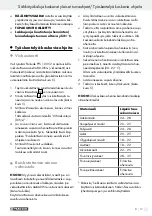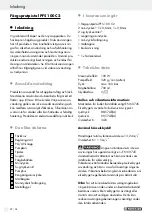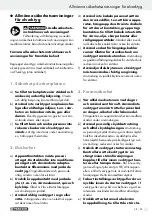
10 GB/IE
Bringing into use / Maintenance and cleaning / Service centre / Warranty
Advice on use / Bringing into use
Material
Flow rate in
seconds
Latex paint
24 – 28
Water-based paint
20 – 25
Primer
24 – 28
Lacquer
20 – 25
Oil-based paint
18 – 22
Glaze
18 – 22
Aluminium paint
22 – 25
Wood sealer
28 – 35
Wood preserver
no diluting
required
Wood stain
no diluting
required
* This device cannot be used to spray media contain-
ing discrete particles / solids. The abrasive effect
of these media shortens pump and valve life.
Q
Preparing the surface
to be sprayed
The surface to be sprayed must be clean, dry and
free of grease.
Roughen smooth surfaces and remove any
abraded dust.
Always cover the surrounding area around the
surface to be sprayed. The spray cloud may
contaminate the surrounding area.
Q
Bringing into use
Q
Selecting the nozzle
Nozzle
Use
nozzle, 0.6 mm
(R6)
8
all paints, varnishes
nozzle, 0.8 mm
(R8)
8
thick-flowing sprayed media
Cleaning nozzle
11
a thinner, harder spray for
spot-cleaning of surfaces
Nozzle
Use
nozzle extension
13
for spraying into corners
which are difficult to reach
Q
Switching oN / oFF
Switching on:
To start the electrical power tool, press the
On / OFF switch
3
and keep it pressed.
Switching off:
To switch off the electrical power tool, release
the On / OFF switch
3
.
Q
Spraying process
1. You can vary the spray by adjusting the regulator
button
2
(see Fig. D). The spray is correctly
set when no drops are formed and the gun
produces a fine, consistent spray pattern.
2. Do not switch the device on or off while it is
over the surface to be sprayed. Instead, start
and stop the spraying process approximately
10 cm outside the surface to be sprayed.
NoTE:
The distance between the nozzle and
the workpiece depends on the material being
sprayed (approx. 20 to 35 cm spraying dis-
tance, depending on the spray cone and the
desired amount of material to be applied).
Use the device in a horizontal orientation only
(as shown in Fig. D).
Carry out a trial in each case to determine the
most effective spraying distance.
Start with a longer distance.
3. Spray corners or small decorative details first
using short bursts of spray.
Then go on to the actual spraying process.
4. The spray process should follow the sequence
shown in Fig. E
– keep the spray gun moving parallel to the surface
– Do not incline the spray gun
– Move the spray gun at a constant speed
– Apply the sprayed medium as thinly as possible
– The layer(s) of sprayed medium need(s) to
be allowed to dry for some time before you
Summary of Contents for 109571
Page 3: ...A B 12 11 13 8 9 1 2 9 10 5 4 3 6 7 8 14 1 2 3...
Page 4: ...F C E x x D 14...
Page 46: ...46...
Page 56: ...56...











































